Novel Collagen Membrane Formulations with Irinotecan or Minocycline for Potential Application in Brain Cancer
Abstract
1. Introduction
- -
- Minocycline: This antibiotic has shown promise in glioblastoma treatment due to its ability to inhibit matrix metalloproteinases (MMPs) and reduce inflammation. MMPs play a role in tumor invasion and angiogenesis, so inhibiting them can help slow down the progression of glioblastoma. Minocycline also has neuroprotective properties, which could help preserve surrounding healthy brain tissue during treatment [13,15].
- -
- Irinotecan: This chemotherapy drug works by inhibiting topoisomerase I, an enzyme involved in DNA replication and repair. By interfering with DNA processes, irinotecan can cause cell death in rapidly dividing cancer cells. In glioblastoma, where cells proliferate quickly, irinotecan can be effective in slowing down tumor growth [16].
2. Materials and Methods
2.1. Materials
2.2. Obtainment of Membranes
2.3. Methods
2.3.1. Water Absorption Tests
2.3.2. Enzymatic Degradation
2.3.3. Antimicrobial Test
2.3.4. In Vitro Drug Release
3. Results and Discussion
3.1. Water Absorption Test
3.2. Enzymatic Degradation
3.3. Antimicrobial Tests
- -
- Staphylococcus aureus: A bacterium that can cause a variety of infections, including surgical site infections and meningitis;
- -
- Streptococcus species: Particularly Streptococcus pneumoniae and Streptococcus pyogenes, which can cause meningitis and brain abscesses;
- -
- Escherichia coli (E. coli): Known for causing surgical site infections and urinary tract infections, but can also contribute to postoperative meningitis in certain cases;
- -
- Pseudomonas aeruginosa: An opportunistic pathogen that can cause various infections, including surgical site infections and meningitis, especially in immunocompromised individuals.
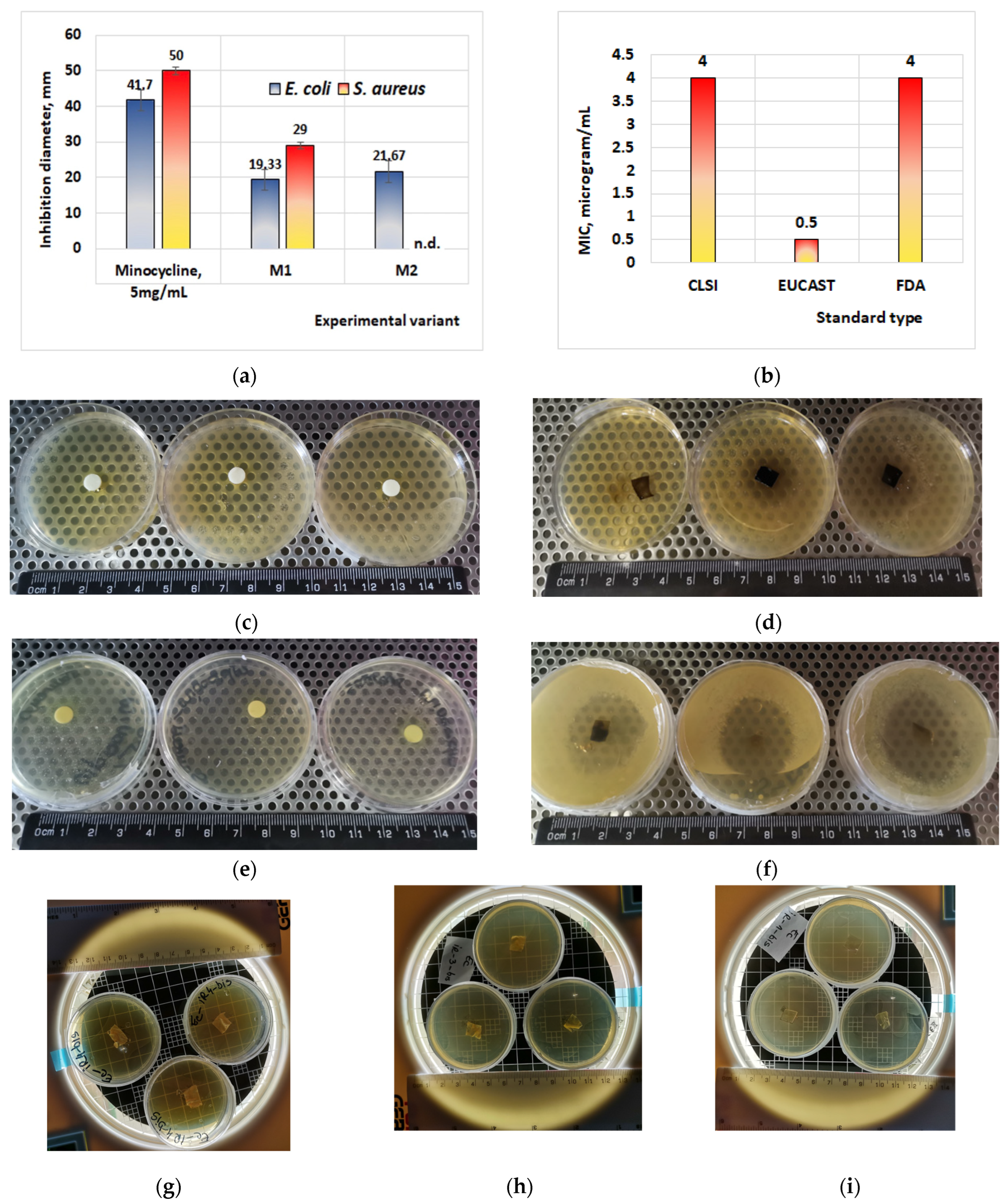
3.4. In Vitro Drug Release
4. Conclusions
Author Contributions
Funding
Institutional Review Board Statement
Informed Consent Statement
Data Availability Statement
Conflicts of Interest
References
- Louis, D.N.; Perry, A.; Reifenberger, G.; von Deimling, A.; Figarella-Branger, D.; Cavenee, W.K.; Ohgaki, H.; Wiestler, O.D.; Kleihues, P.; Ellison, D.W. The 2016 World Health Organization Classification of Tumors of the Central Nervous System: A summary. Acta Neuropathol. 2016, 131, 803–820. [Google Scholar] [CrossRef] [PubMed]
- Weller, M.; van den Bent, M.; Hopkins, K.; Tonn, J.C.; Stupp, R.; Falini, A.; Cohen-Jonathan-Moyal, E.; Frappaz, D.; Henriksson, R.; Balana, C.; et al. EANO guideline for the diagnosis and treatment of anaplastic gliomas and glioblastoma. Lancet Oncol. 2014, 15, e395–e403. [Google Scholar] [CrossRef] [PubMed]
- Weller, M.; van den Bent, M.; Tonn, J.C.; Stupp, R.; Preusser, M.; Cohen-Jonathan-Moyal, E.; Henriksson, R.; Le Rhun, E.; Balana, C.; Chinot, O.; et al. European Association for Neuro-Oncology (EANO) guideline on the diagnosis and treatment of adult astrocytic and oligodendroglial gliomas. Lancet Oncol. 2017, 18, e315–e329. [Google Scholar] [CrossRef] [PubMed]
- Soffietti, R.; Baumert, B.G.; Bello, L.; Von Deimling, A.; Duffau, H.; Frénay, M.; Grisold, W.; Grant, R.; Graus, F.; Hoang-Xuan, K.; et al. Guidelines on management of low-grade gliomas: Report of an EFNS-EANO Task Force. Eur. J. Neurol. 2010, 17, 1124–1133. [Google Scholar] [CrossRef] [PubMed]
- Wen, P.Y.; Macdonald, D.R.; Reardon, D.A.; Cloughesy, T.F.; Sorensen, A.G.; Galanis, E.; Degroot, J.; Wick, W.; Gilbert, M.R.; Lassman, A.B.; et al. Updated response assessment criteria for high-grade gliomas: Response assessment in neuro-oncology working group. J. Clin. Oncol. 2010, 28, 1963–1972. [Google Scholar] [CrossRef] [PubMed]
- Cairncross, G.; Wang, M.; Shaw, E.; Jenkins, R.; Brachman, D.; Buckner, J.; Fink, K.; Souhami, L.; Laperriere, N.; Curran, W.; et al. Phase III trial of chemoradiotherapy for anaplastic oligodendroglioma: Long-term results of RTOG 9402. J. Clin. Oncol. 2013, 31, 337–343. [Google Scholar] [CrossRef] [PubMed]
- Sahm, F.; Reuss, D.; Koelsche, C.; Capper, D.; Schittenhelm, J.; Heim, S.; Jones, D.T.; Pfister, S.M.; Herold-Mende, C.; Wick, W.; et al. Farewell to oligoastrocytoma: In situ molecular genetics favor classification as either oligodendroglioma or astrocytoma. Acta Neuropathol. 2014, 128, 551–559. [Google Scholar] [CrossRef]
- Herrlinger, U.; Jones, D.T.W.; Glas, M.; Hattingen, E.; Gramatzki, D.; Stuplich, M.; Felsberg, J.; Bähr, O.; Gielen, G.H.; Simon, M.; et al. Gliomatosis cerebri: No evidence for a separate brain tumor entity. Acta Neuropathol. 2016, 131, 309–319. [Google Scholar] [CrossRef]
- Weller, M.; Pfister, S.M.; Wick, W.; Hegi, M.E.; Reifenberger, G.; Stupp, R. Molecular neuro-oncology in clinical practice: A new horizon. Lancet Oncol. 2013, 14, e370–e379. [Google Scholar] [CrossRef] [PubMed]
- Stummer, W.; Pichlmeier, U.; Meinel, T.; Wiestler, O.D.; Zanella, F.; Reulen, H.J.; ALA-Glioma Study Group. Fluorescence-guided surgery with 5-aminolevulinic acid for resection of malignant glioma: A randomised controlled multicentre phase III trial. Lancet Oncol. 2006, 7, 392–401. [Google Scholar] [CrossRef]
- De Witt Hamer, P.C.; Robles, S.G.; Zwinderman, A.H.; Duffau, H.; Berger, M.S. Impact of intraoperative stimulation brain mapping on glioma surgery outcome: A meta-analysis. J. Clin. Oncol. 2012, 30, 2559–2565. [Google Scholar] [CrossRef] [PubMed]
- Osswald, M.; Jung, E.; Sahm, F.; Solecki, G.; Venkataramani, V.; Blaes, J.; Weil, S.; Horstmann, H.; Wiestler, B.; Syed, M.; et al. Brain tumour cells interconnect to a functional and resistant network. Nature 2015, 528, 93–98. [Google Scholar] [CrossRef]
- Markovic, D.S.; Vinnakota, K.; van Rooijen, N.; Kiwit, J.; Synowitz, M.; Glass, R.; Kettenmann, H. Minocycline reduces glioma expansion and invasion by attenuating microglial MT1-MMP expression. Brain Behav. Immun. 2011, 25, 624–628. [Google Scholar] [CrossRef]
- Reese, T.S.; Karnovsky, M.J. Fine structural localization of a blood-brain barrier to exogenous peroxidase. J. Cell Biol. 1967, 34, 207–217. [Google Scholar] [CrossRef] [PubMed]
- Afshari, A.R.; Mollazadeh, H.; Sahebkar, A. Minocycline in Treating Glioblastoma Multiforme: Far Beyond a Conventional Antibiotic. J. Oncol. 2020, 2020, 8659802. [Google Scholar] [CrossRef]
- Cruickshank, G.; Ngoga, D.; Detta, A.; Lewis, A.; Holden, R.; Fayaye, O. Local Delivery of Irinotecan to Recurrent Glioblastoma At Reoperation Offers A Safe Therapeutic Advantage Over Systemic Delivery. Neuro Oncol. 2018, 20 (Suppl. S1), i1. [Google Scholar] [CrossRef]
- Gawley, M.; Almond, L.; Daniel, S.; Lastakchi, S.; Kaur, S.; Detta, A.; Cruickshank, G.; Miller, R.; Hingtgen, S.; Sheets, K.; et al. Development and in vivo evaluation of Irinotecan-loaded Drug Eluting Seeds (iDES) for the localised treatment of recurrent glioblastoma multiforme. J. Control. Release 2020, 324, 1–16. [Google Scholar] [CrossRef]
- Molinaro, A.M.; Taylor, J.W.; Wiencke, J.K.; Wrensch, M.R. Genetic and molecular epidemiology of adult diffuse glioma. Nat. Rev. Neurol. 2019, 15, 405–417. [Google Scholar] [CrossRef] [PubMed]
- Taphoorn, M.J.; Henriksson, R.; Bottomley, A.; Cloughesy, T.; Wick, W.; Mason, W.P.; Saran, F.; Nishikawa, R.; Hilton, M.; Theodore-Oklota, C.; et al. Health-Related Quality of Life in a Randomized Phase III Study of Bevacizumab, Temozolomide, and Radiotherapy in Newly Diagnosed Glioblastoma. J. Clin. Oncol. 2015, 33, 2166–2175. [Google Scholar] [CrossRef]
- Folstein, M.F.; Folstein, S.E.; McHugh, P.R. “Mini-mental state”. A practical method for grading the cognitive state of patients for the clinician. J. Psychiatr. Res. 1975, 12, 189–198. [Google Scholar] [CrossRef] [PubMed]
- Ellingson, B.M.; Bendszus, M.; Boxerman, J.; Barboriak, D.; Erickson, B.J.; Smits, M.; Nelson, S.J.; Gerstner, E.; Alexander, B.; Goldmacher, G.; et al. Consensus recommendations for a standardized Brain Tumor Imaging Protocol in clinical trials. Neuro Oncol. 2015, 17, 1188–1198. [Google Scholar] [CrossRef] [PubMed]
- Weller, M.; Stupp, R.; Wick, W. Epilepsy meets cancer: When, why, and what to do about it? Lancet Oncol. 2012, 13, e375–e382. [Google Scholar] [CrossRef] [PubMed]
- Albert, N.L.; Weller, M.; Suchorska, B.; Galldiks, N.; Soffietti, R.; Kim, M.M.; la Fougère, C.; Pope, W.; Law, I.; Arbizu, J.; et al. Response Assessment in Neuro-Oncology working group and European Association for Neuro-Oncology recommendations for the clinical use of PET imaging in gliomas. Neuro Oncol. 2016, 18, 1199–1208. [Google Scholar] [CrossRef] [PubMed]
- Nasreddine, Z.S.; Phillips, N.A.; Bédirian, V.; Charbonneau, S.; Whitehead, V.; Collin, I.; Cummings, J.L.; Chertkow, H. The Montreal Cognitive Assessment, MoCA: A brief screening tool for mild cognitive impairment. J. Am. Geriatr. Soc. 2005, 53, 695–699. [Google Scholar] [CrossRef] [PubMed]
- Douw, L.; Klein, M.; Fagel, S.S.; van den Heuvel, J.; Taphoorn, M.J.; Aaronson, N.K.; Postma, T.J.; Vandertop, W.P.; Mooij, J.J.; Boerman, R.H.; et al. Cognitive and radiological effects of radiotherapy in patients with low-grade glioma: Long-term follow-up. Lancet Neurol. 2009, 8, 810–818. [Google Scholar] [CrossRef]
- Peng, Y.Y.; Glattauer, V.; Ramshaw, J.A.M. Stabilisation of Collagen Sponges by Glutaraldehyde Vapour Crosslinking. Int. J. Biomater. 2017, 2017, 8947823. [Google Scholar] [CrossRef]
- Hecht, J.R. Gastrointestinal toxicity of Irinotecan. Oncology 1998, 12, 72–78. [Google Scholar]
- Giuliani, F.; Hader, W.; Yong, V.W. Minocycline attenuates T cell and microglia activity to impair cytokine production in T cell-microglia interaction. J. Leukoc. Biol. 2005, 78, 135–143. [Google Scholar] [CrossRef] [PubMed]
- Frazier, J.L.; Wang, P.P.; Case, D.; Tyler, B.M.; Pradilla, G.; Weingart, J.D.; Brem, H. Local Delivery of Minocycline and Systemic BCNU have Synergistic Activity in the Treatment of Intracranial Glioma. J. Neurooncol. 2003, 64, 203–209. [Google Scholar] [CrossRef]
- Radu, N.; Ghita, I.; Rau, I. Therapeutic Effect of Polysaccharides from Plantago Species. Mol. Cryst. Liq. Cryst. 2010, 523, 236–808. [Google Scholar] [CrossRef]
- Zaharie, M.-G.O.; Radu, N.; Pirvu, L.; Bostan, M.; Voicescu, M.; Begea, M.; Constantin, M.; Voaides, C.; Babeanu, N.; Roman, V. Studies Regarding the Pharmaceutical Potential of Derivative Products from Plantain. Plants 2022, 11, 1827. [Google Scholar] [CrossRef] [PubMed]
- Tihan, G.T.; Rău, I.; Zgârian, R.G.; Ungureanu, C.; Barbaresso, R.C.; Kaya, M.G.A.; Dinu-Pîrvu, C.; Ghica, M.V. Oxytetracycline versus Doxycycline Collagen Sponges Designed as Potential Carrier Supports in Biomedical Applications. Pharmaceutics 2019, 11, 363. [Google Scholar] [CrossRef] [PubMed]
- Ghica, M.V.; Albu, M.G.; Popa, L.; Moisescu, S. Response surface methodology and Taguchi approach to assess the combined effect of formulation factors on minocycline delivery from collagen sponges. Pharmazie 2013, 68, 340–348. [Google Scholar]
- Urbańska, K.; Sokołowska, J.; Szmidt, M.; Sysa, P. Glioblastoma multiforme—An overview. Contemp. Oncol. 2014, 18, 307–312. [Google Scholar] [CrossRef]
- Rosenberg, G.A.; Estrada, E.; Kelley, R.O.; Kornfeld, M. Bacterial collagenase disrupts extracellular matrix and opens blood-brain barrier in rat. Neurosci Lett. 1993, 160, 117–119. [Google Scholar] [CrossRef]
- Sotomayor, E.A.; Teicher, B.A.; Schwartz, G.N.; Holden, S.A.; Menon, K.; Herman, T.S.; Frei, E., 3rd. Minocycline in combination with chemotherapy or radiation therapy in vitro and in vivo. Cancer Chemother. Pharmacol. 1992, 30, 377–384. [Google Scholar] [CrossRef] [PubMed]
- Sharma, B.S.; Gupta, S.K.; Khosla, V.K. Current concepts in the management of pyogenic brain abscess. Neurol. India 2000, 48, 105–111. [Google Scholar]
- Raswan, U.; Khursheed, N.; Makhdoomi, R.; Ramzan, A. Brain Abscess after Glioblastoma Resection: An Unusual Case Report. Surg. Infect. Case Rep. 2017, 2, 69–71. [Google Scholar] [CrossRef]
- Duntze, J.; Litre, C.F.; Bajolet, O.; Theret, E.; Eap, C.; Peruzzi, P.; Rousseaux, P. Clostridial brain abscess after glioblastoma resection: Case report and critical review of the literature. J. Neurochir. 2009, 55, 569–572. [Google Scholar] [CrossRef]
- Staphylococcus aureus Calibration of Zone Diameter Breakpoints to MIC Values and/or Resistance Mechanisms Version 11.0 January 2024. Available online: https://www.eucast.org (accessed on 12 March 2024).
- Chopra, S.; Harjai, K.; Chhibber, S. Potential of sequential treatment with minocycline and S. aureus specific phage lysin in eradication of MRSA biofilms: An in vitro study. Appl. Microbiol. Biotechnol. 2015, 99, 3201–3210. [Google Scholar] [CrossRef]
- Phair, J.P.; Hartman, R.E.; Carleton, J. Evaluation of the efficacy of minocycline therapy for staphylococcal soft-tissue infection. Antimicrob. Agents Chemother. 1974, 6, 551–553. [Google Scholar] [CrossRef][Green Version]
- Lewis, S.A.; Altemeier, W.A. Correlation of in vitro resistance of Staphylococcus aureus to tetracycline, doxycycline, and minocycline with in vivo use. Chemotherapy 1976, 22, 319–323. [Google Scholar] [CrossRef]
- Bidell, M.R.; Lodise, T.P. Use of oral tetracyclines in the treatment of adult outpatients with skin and skin structure infections: Focus on doxycycline, minocycline, and omadacycline. Pharmacotherapy 2021, 41, 915–931. [Google Scholar] [CrossRef] [PubMed]
- Garrido-Mesa, N.; Zarzuelo, A.; Gálvez, J. Minocycline: Far beyond an antibiotic. Br. J. Pharmacol. 2013, 169, 337–352. [Google Scholar] [CrossRef]
- Garrido-Mesa, N.; Zarzuelo, A.; Gálvez, J. What is behind the non-antibiotic properties of minocycline? Pharmacol. Res. 2013, 67, 18–30. [Google Scholar] [CrossRef] [PubMed]
- Dheen, S.T.; Kaur, C.; Ling, E.A. Microglial activation and its implications in the brain diseases. Curr. Med. Chem. 2007, 14, 1189–1197. [Google Scholar] [CrossRef] [PubMed]
- Strickland, B.A.; Bakhsheshian, J.; Emmanuel, B.; Amar, A.; Giannotta, S.L.; Russin, J.J.; Mack, W. Neuroprotective effect of minocycline against acute brain injury in clinical practice: A systematic review. J. Clin. Neurosci. 2021, 86, 50–57. [Google Scholar] [CrossRef] [PubMed]
- Meshkini, A.; Ohadi, M.A.D.; Mirghaderi, P.; Mirzaei, F.; Rafiei, E.; Allahyari, N.; Namvar, M.; Iranmehr, A. Combined treatment with Minocycline and methylprednisolone in acute traumatic spinal cord injury: A pilot study. Interdiscip. Neurosurg. 2024, 36, 101883. [Google Scholar] [CrossRef]
- Ioan, D.-C.; Rău, I.; Kaya, M.G.A.; Radu, N.; Bostan, M.; Zgârian, R.G.; Tihan, G.T.; Dinu-Pîrvu, C.-E.; Lupuliasa, A.; Ghica, M.V. Ciprofloxacin–collagen-based materials with potential oral surgical applications. Polymers 2020, 12, 1915. [Google Scholar] [CrossRef]
- Nitipir, C.; Albu, M.G.; Voicu, G.; Ficai, A.; Barbu, M.A.; Popa, L.G.; Mirea, D.; Lazar, S.; Levai, C.; Ghica, M.V. Collagen—Vinblastine delivery systems as a new treatment for Kaposi’s sarcoma. Rev. Chim. 2015, 66, 1169–1172. [Google Scholar]
- Abdelnabi, D.; Lastakchi, S.; Watts, C.; Atkins, H.; Hingtgen, S.; Valdivia, A.; McConville, C. Local administration of irinotecan using an implantable drug delivery device stops high-grade glioma tumor recurrence in a glioblastoma tumor model. Drug Deliv. Transl. Res, 2024; ahead of print. [Google Scholar] [CrossRef]
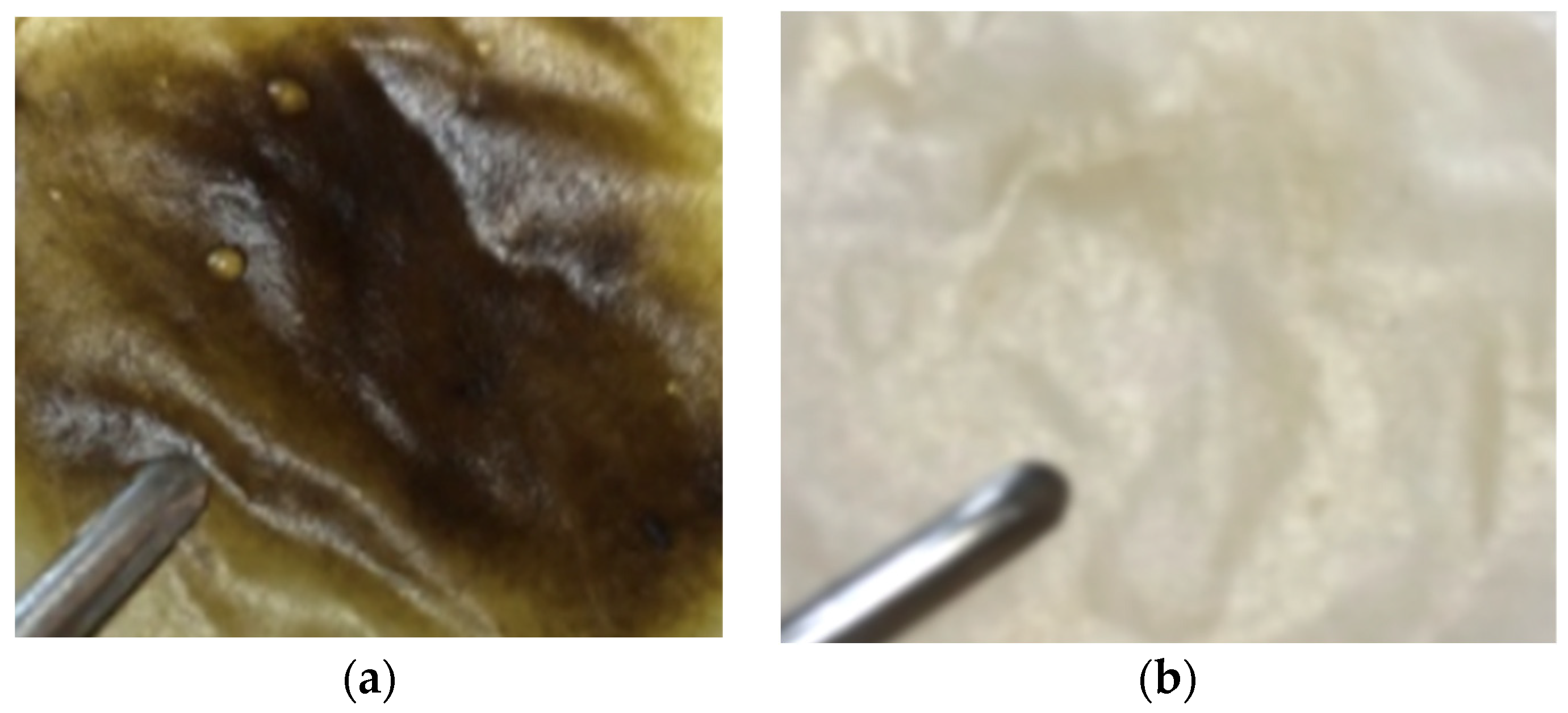
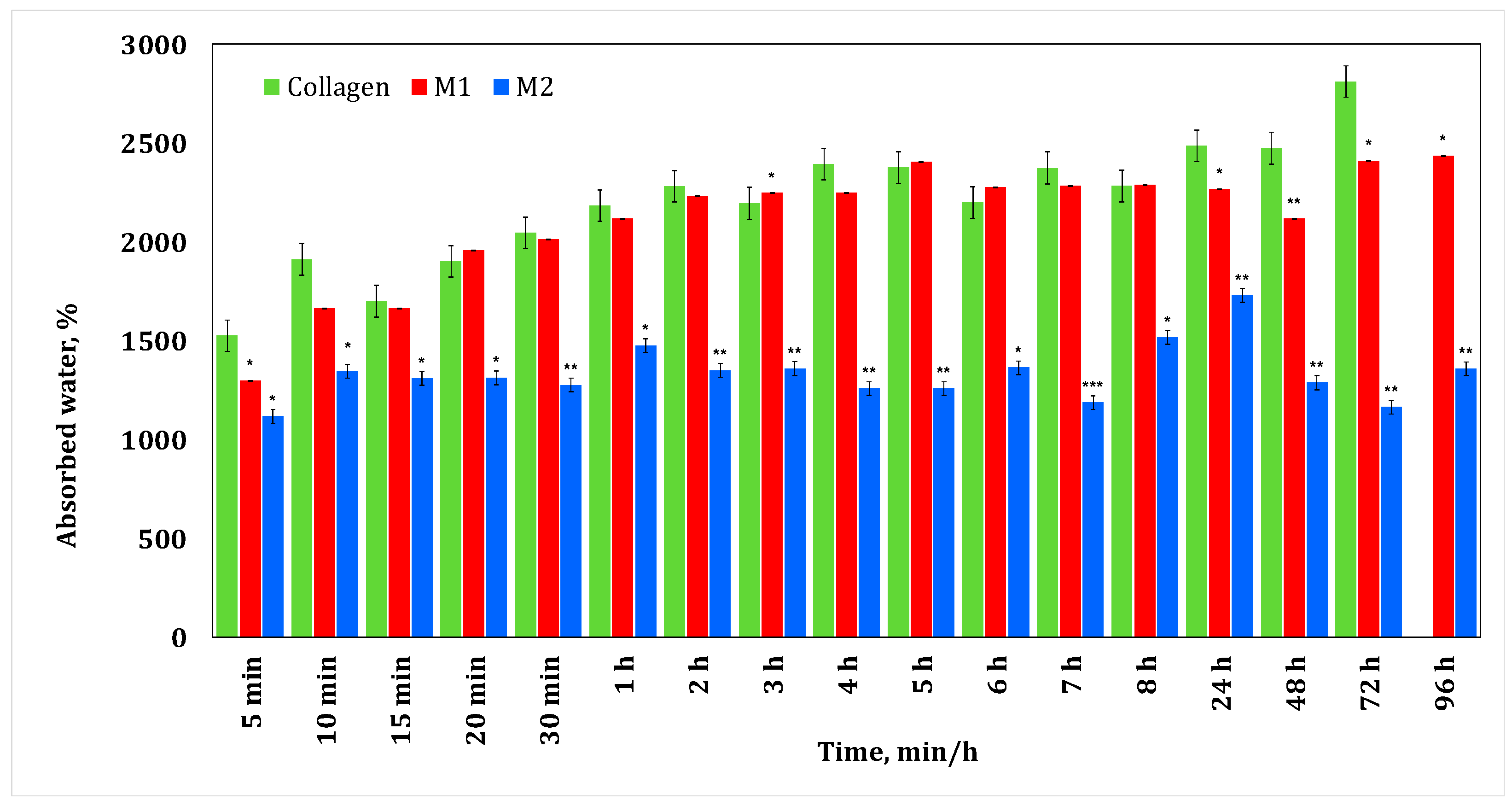
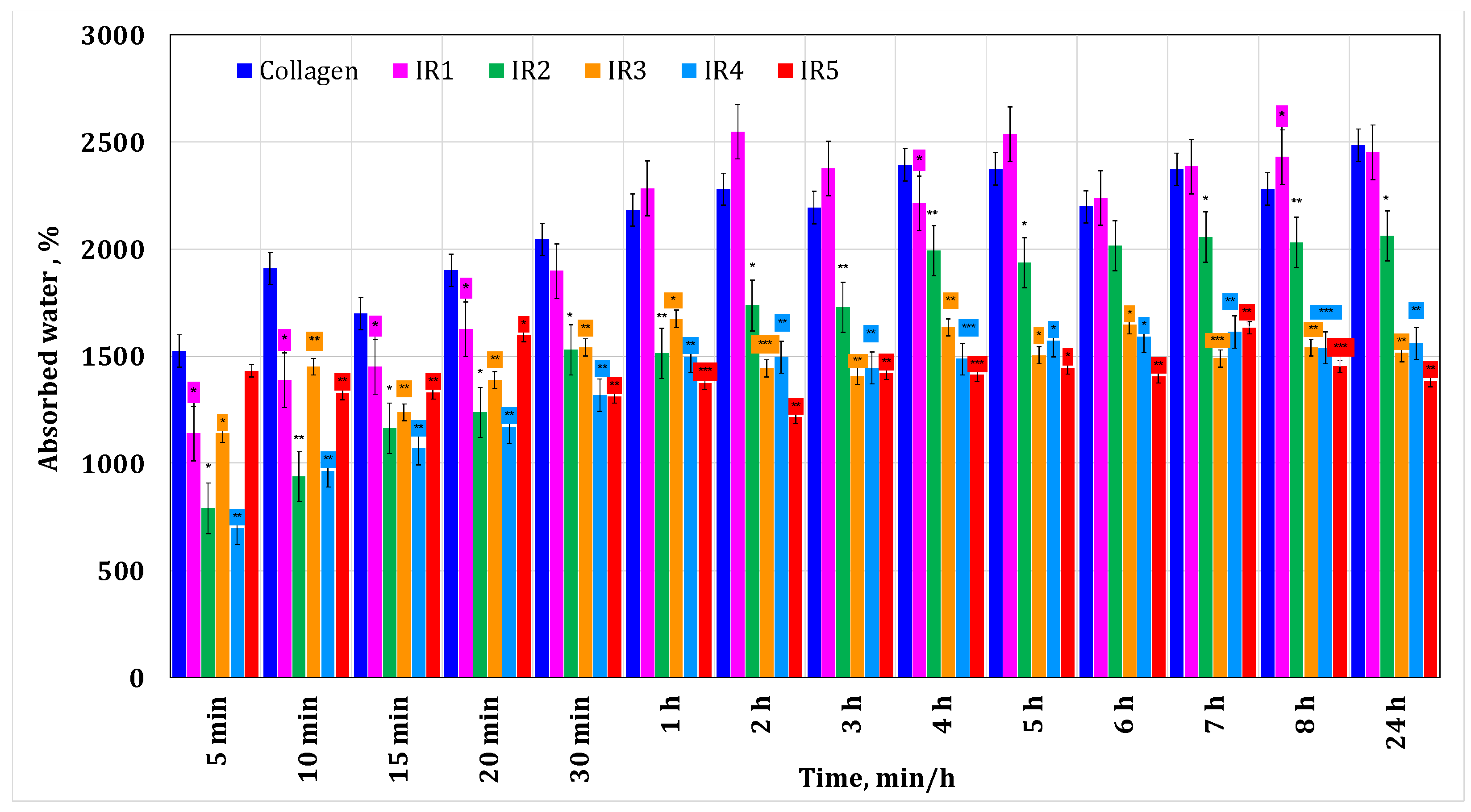
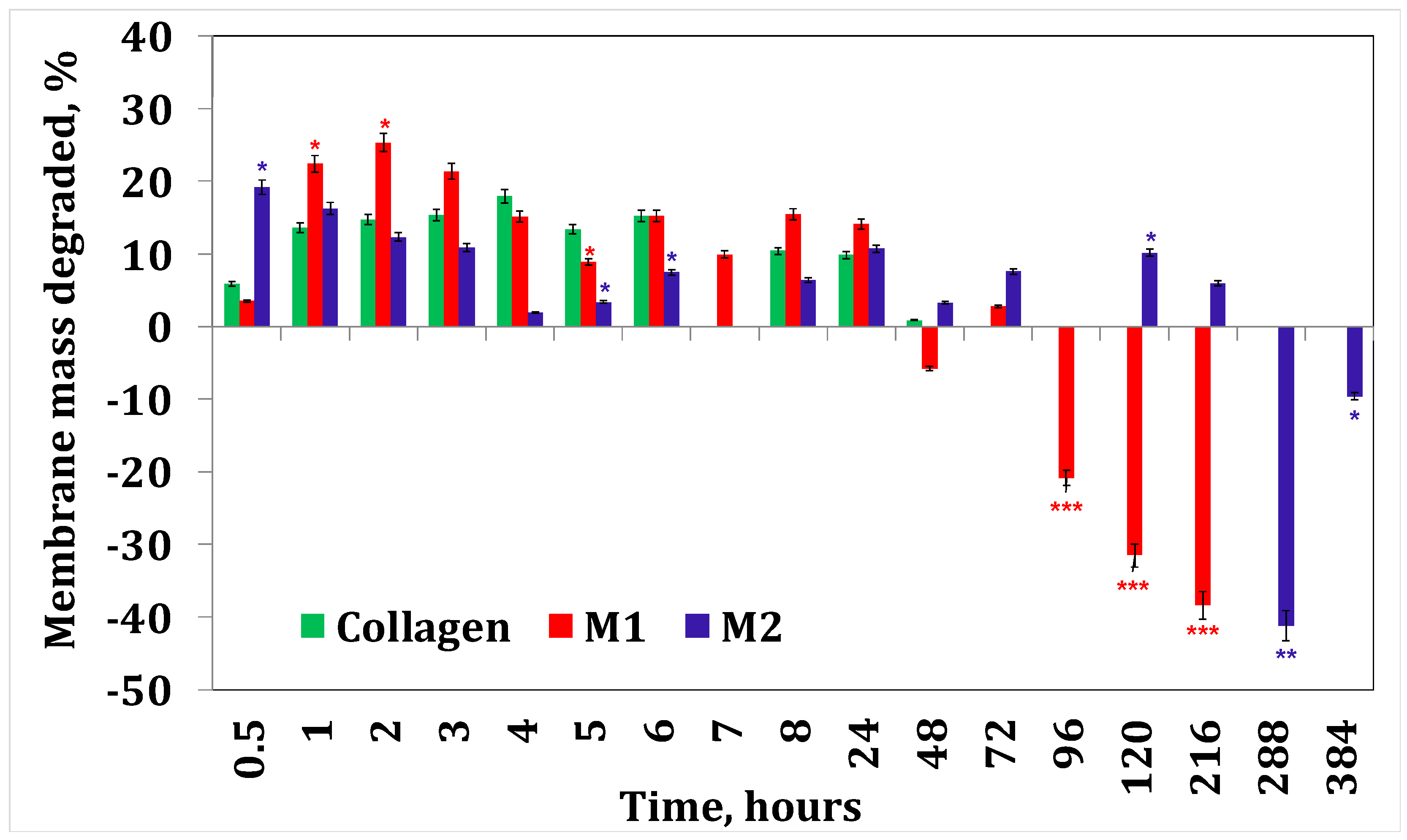
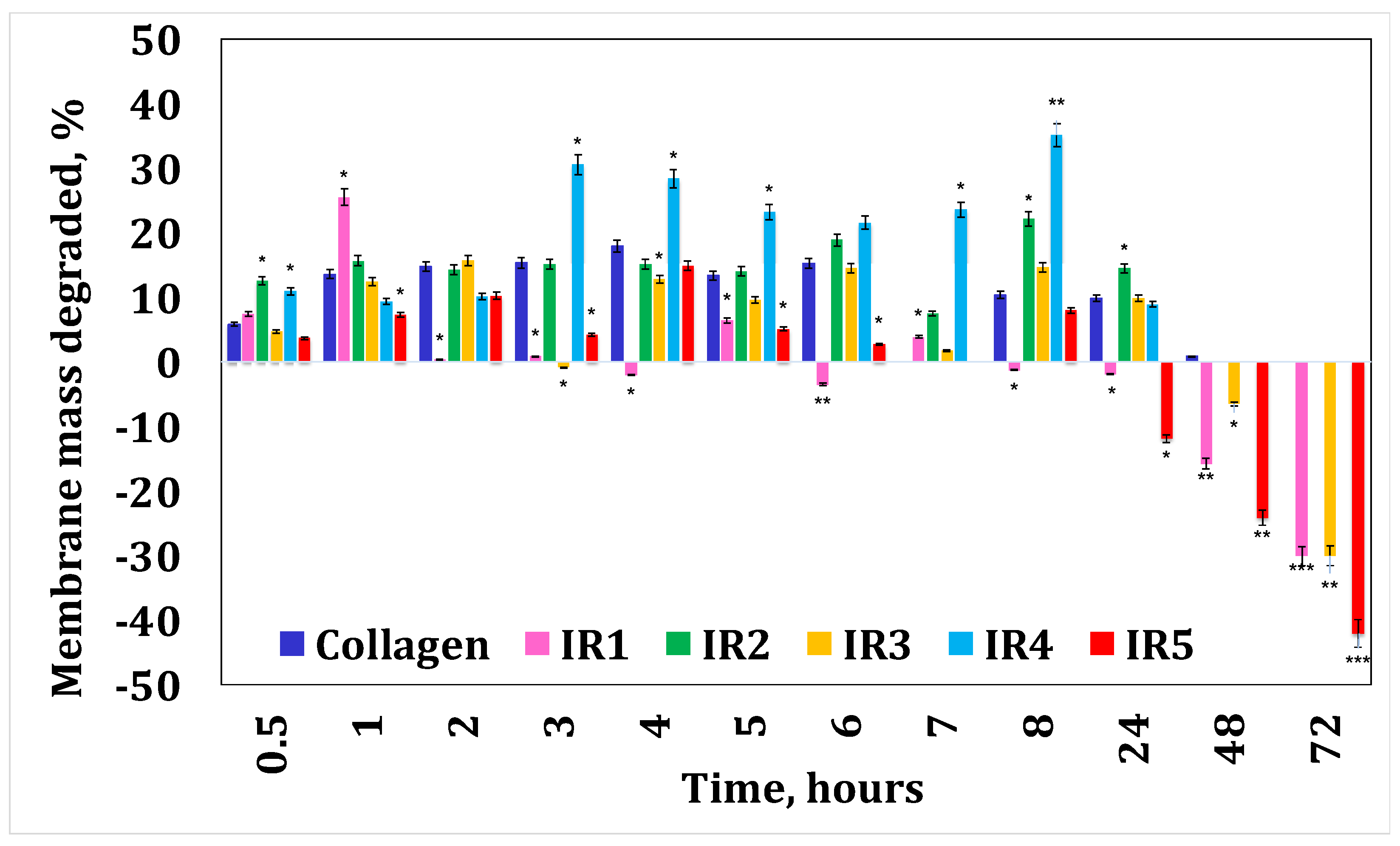
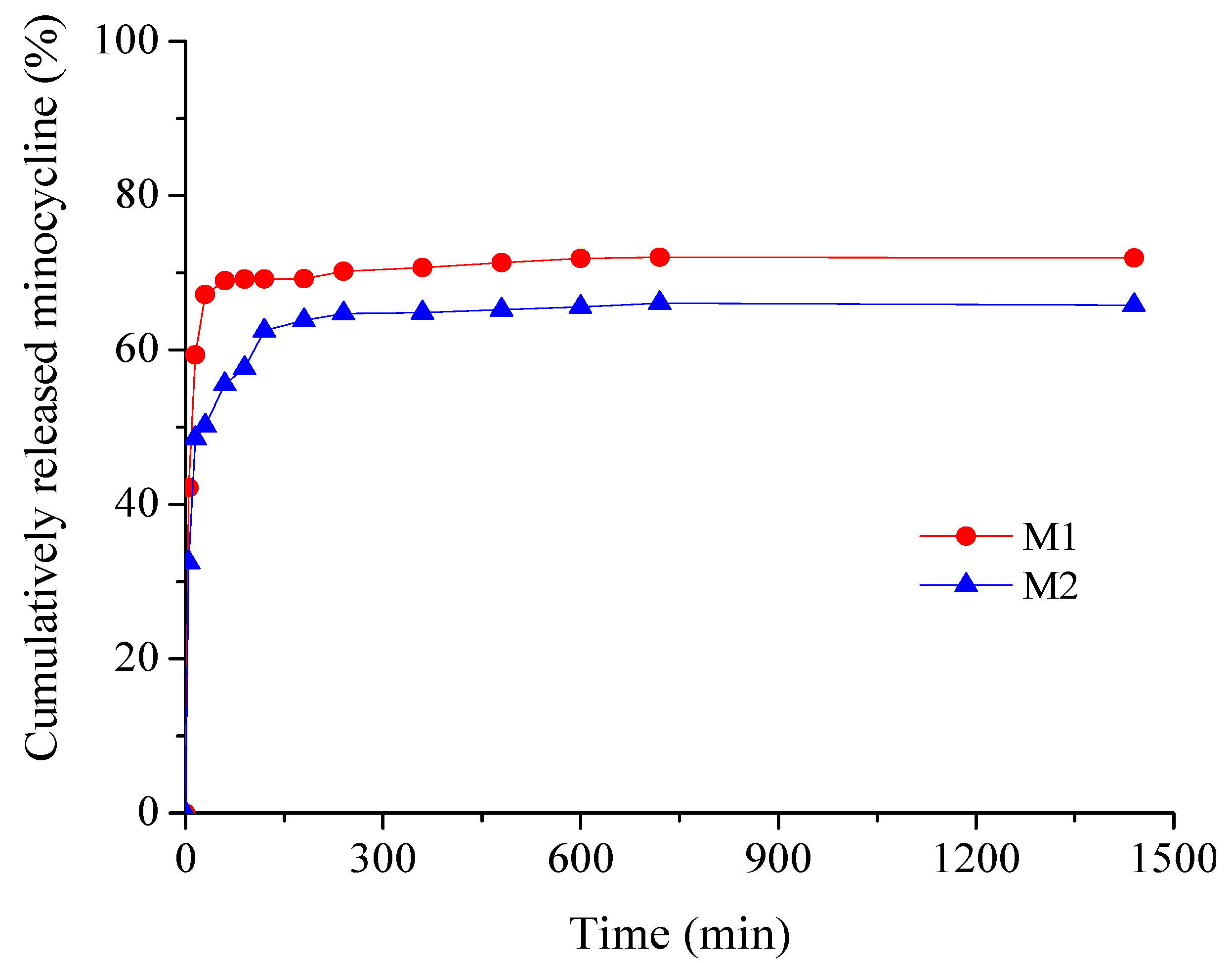
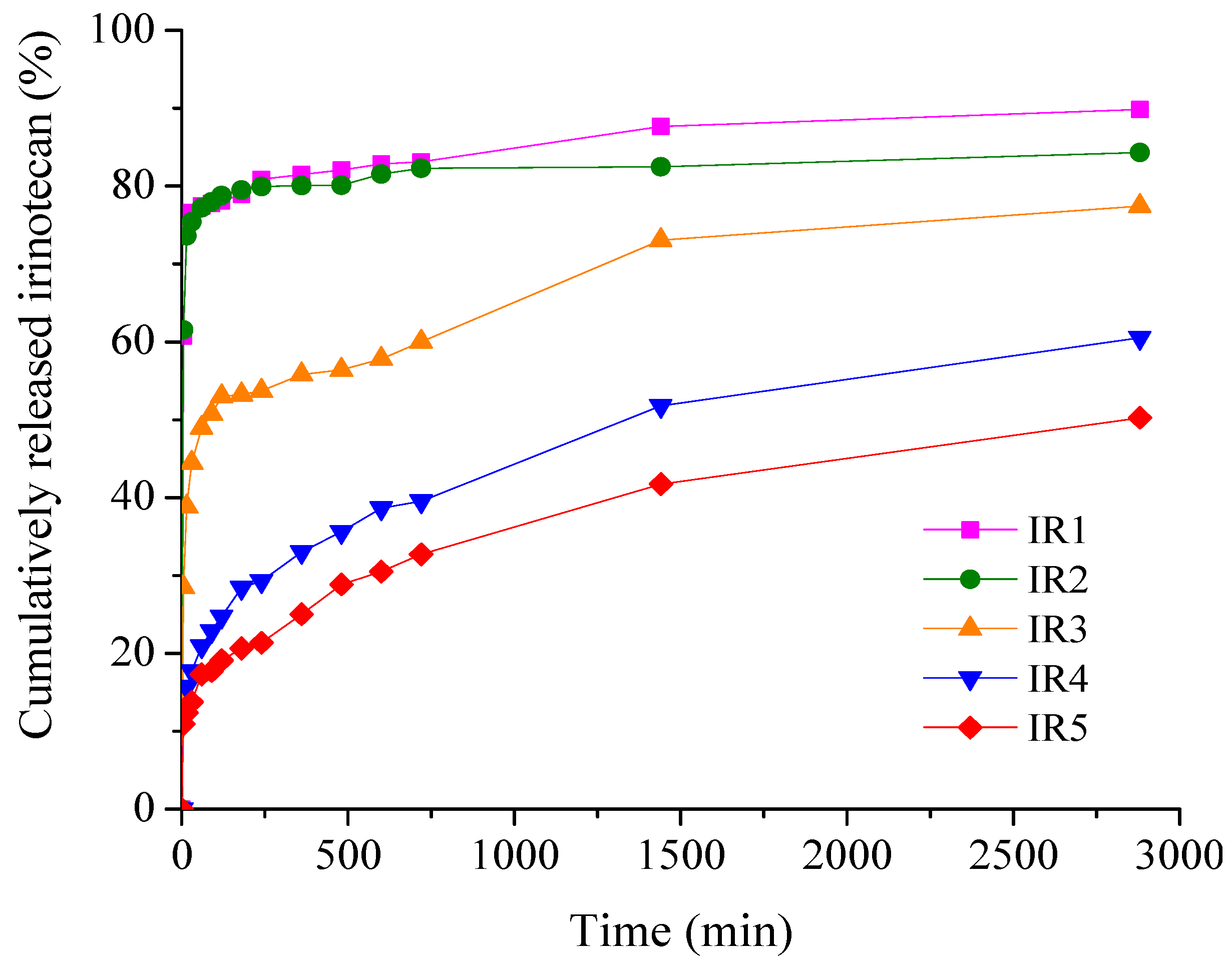
| Sample Code | Minocycline (%) | Irinotecan (%) |
|---|---|---|
| C | 0 | 0 |
| M1 | 20 | - |
| M2 | 40 | |
| IR1 | - | 10 |
| IR2 | - | 20 |
| IR3 | - | 30 |
| IR4 | - | 40 |
| IR5 | - | 50 |
Disclaimer/Publisher’s Note: The statements, opinions and data contained in all publications are solely those of the individual author(s) and contributor(s) and not of MDPI and/or the editor(s). MDPI and/or the editor(s) disclaim responsibility for any injury to people or property resulting from any ideas, methods, instructions or products referred to in the content. |
© 2024 by the authors. Licensee MDPI, Basel, Switzerland. This article is an open access article distributed under the terms and conditions of the Creative Commons Attribution (CC BY) license (https://creativecommons.org/licenses/by/4.0/).
Share and Cite
Idu, A.-A.; Albu Kaya, M.G.; Rău, I.; Radu, N.; Dinu-Pîrvu, C.-E.; Ghica, M.V. Novel Collagen Membrane Formulations with Irinotecan or Minocycline for Potential Application in Brain Cancer. Materials 2024, 17, 3510. https://doi.org/10.3390/ma17143510
Idu A-A, Albu Kaya MG, Rău I, Radu N, Dinu-Pîrvu C-E, Ghica MV. Novel Collagen Membrane Formulations with Irinotecan or Minocycline for Potential Application in Brain Cancer. Materials. 2024; 17(14):3510. https://doi.org/10.3390/ma17143510
Chicago/Turabian StyleIdu, Andreea-Anamaria, Mădălina Georgiana Albu Kaya, Ileana Rău, Nicoleta Radu, Cristina-Elena Dinu-Pîrvu, and Mihaela Violeta Ghica. 2024. "Novel Collagen Membrane Formulations with Irinotecan or Minocycline for Potential Application in Brain Cancer" Materials 17, no. 14: 3510. https://doi.org/10.3390/ma17143510
APA StyleIdu, A.-A., Albu Kaya, M. G., Rău, I., Radu, N., Dinu-Pîrvu, C.-E., & Ghica, M. V. (2024). Novel Collagen Membrane Formulations with Irinotecan or Minocycline for Potential Application in Brain Cancer. Materials, 17(14), 3510. https://doi.org/10.3390/ma17143510










